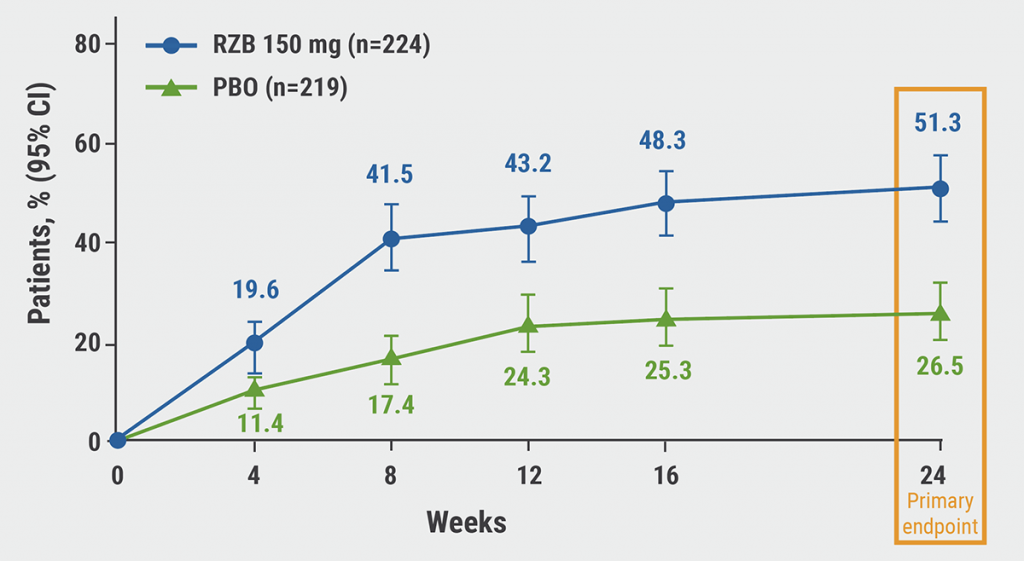AAU is an inflammation of the anterior uveal tract characterised by blurred vision, photophobia, and pain [2]. It is reported in up to 40% of axSpA patients, which makes it the most common extra-articular manifestation in axSpA patients [3]. Previous studies have shown that TNF inhibitor (TNFi) monoclonal antibodies may reduce AAU flare incidence in patients with radiographic axSpA, but data in non-radiographic axSpA is scarce [4-6].
Prof. Irene van der Horst-Bruinsma (Amsterdam University Medical Center, the Netherlands) presented the results of the phase 4 C-VIEW trial that analysed the impact of certolizumab pegol treatment on AAU in patients with active radiographic and non-radiographic axSpA and a recent history of AAU. Eligible patients (n=115) had adult-onset axSpA with ≥3 months symptom duration, active radiographic or non-radiographic axSpA (Bath Ankylosing Spondylitis Disease Activity Index [BASDAI] score ≥4 and spinal pain ≥4), inadequate response or contraindication to ≥2 non-steroidal anti-inflammatory drugs (NSAIDs), HLA-B27 positivity, and ≥2 prior AAU flares (with at least 1 flare in the 12 months pre-baseline). Exclusion criteria were any other inflammatory arthritis and prior exposure to >1 TNFi, or primary failure/hypersensitivity to any TNFi.
Participants received certolizumab pegol 400 mg at weeks 0, 2, and 4, then 200 mg every 2 weeks to week 96. The primary variable was incidence of AAU flares compared with historic rates. A pre-specified interim analysis compared AAU incidence in the 48 weeks prior to certolizumab pegol treatment with the 48 weeks of treatment, using Poisson regression adjusted for possible within-patient correlations, with pre- and post-baseline period and axSpA disease duration as covariates. The incidence rates (IR) were calculated based on the number of cases/patients at risk over 48 weeks. Of the 115 participants, 89 initiated certolizumab pegol treatment and 85 patients completed week 48. Mean age of the patients was 46.5 years, 37.1% was female, and 97.8% was Caucasian. The percentage of radiographic axSpA was 85.4%, and 14.6% had non-radiographic axSpA. Mean time since diagnosis was 8.6 years, and mean time since onset of first uveitis flare was 9.9 years. Mean Ankylosing Spondylitis Disease Activity Score (ASDAS) was 3.5 ± 0.9, and mean BASDAI was 6.5 ± 1.5.
Results from this 48-week interim analysis showed that significantly fewer patients had AAU flares during certolizumab pegol treatment than before treatment (IR 0.2 vs 1.5; P<0.001). The number of patients experiencing 1 or ≥2 AAU flares (64.0% and 31.5% at baseline, respectively) was substantially reduced during certolizumab pegol treatment (12.4% and 2.2%, respectively). After 48 weeks of treatment, disease activity improved substantially (mean ± SD ASDAS 2.0 ± 0.9; BASDAI 3.3 ± 2.1); 31.4% of patients achieved ASDAS partial remission and 29.1% ASDAS major improvement.
The authors concluded that 48 weeks of treatment with certolizumab pegol resulted in an 87% reduction in AAU flare rate and substantial improvements in axSpA disease activity, while no new safety signals came to light. These findings suggest certolizumab pegol may be a suitable treatment option for patients with axSpA and a history of recurrent AAU.
- Van der Horst-Bruinsma I, et al. THU0379. EULAR E-Congress, 3-6 June 2020.
- Bacchiega ABS, et al. Rheumatology 2017;56:2060-2067.
- Martin TM, et al. Curr Opin Rheumatol 2002;14:337-341.
- Van der Heijde D, et al. Rheumatology 2017;56:1498-1509.
- Van Bentum RE, et al. J Rheumatol. 2019;46:153-159.
- Van Denderen JC, et al. J Rheumatol 2014;41:1843-1848.
Posted on
Previous Article
« TNF-α inhibitors improve bone mineral density in AS patients Next Article
AxSpA real-life remission rates higher on biologics »
« TNF-α inhibitors improve bone mineral density in AS patients Next Article
AxSpA real-life remission rates higher on biologics »
Table of Contents: EULAR 2020
Featured articles
COVID-19 and inflammatory rheumatic disease: some key issues
Secukinumab monotherapy as efficient as adalimumab
AxSpA real-life remission rates higher on biologics
Olokizumab significantly improves RA features and patient-reported outcomes
Rheumatoid Arthritis
New nanoparticle promising future agent in RA
Olokizumab significantly improves RA features and patient-reported outcomes
Low DAS at 4 months predicts sustained DMARD-free remission
Ankylosing Spondylitis
Reduced maintenance dose of certolizumab pegol can be used in axSpA
Worse response axSpA patients to second TNFi versus first TNFi
AxSpA real-life remission rates higher on biologics
Certolizumab pegol reduces acute anterior uveitis in axial spondyloarthritis
TNF-α inhibitors improve bone mineral density in AS patients
Psoriatic Arthritis
Ixekizumab shows sustained improvements in pain and fatigue at 3 years
Adalimumab added to methotrexate yields better results in PsA than methotrexate escalatio
Upadacitinib provides fast onset of improvement in psoriatic arthritis
Secukinumab monotherapy as efficient as adalimumab
Osteoporosis and Osteoarthritis
Higher mortality risk with tramadol versus NSAIDs for osteoarthritis patients
Hydroxychloroquine not effective in patients with hand osteoarthritis
Positive effect denosumab on fall risk
Systemic Sclerosis and Systemic Lupus Erythematosus
Anifrolumab achieves rapid and durable BICLA-response
Subclinical myocardial involvement progresses in SSc patients
Composite endpoint CRESS for primary Sjögren’s syndrome
COVID-19
COVID-19 and inflammatory rheumatic disease: some key issues
Related Articles

July 17, 2024
Improving outcomes in pregnancy and psoriatic disease
© 2024 Medicom Medical Publishers. All rights reserved. Terms and Conditions | Privacy Policy
HEAD OFFICE
Laarderhoogtweg 25
1101 EB Amsterdam
The Netherlands
T: +31 85 4012 560
E: publishers@medicom-publishers.com

